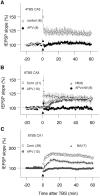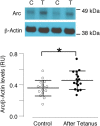Metabotropic Glutamate Receptors Induce a Form of LTP Controlled by Translation and Arc Signaling in the Hippocampus
- PMID: 26843652
- PMCID: PMC4737780
- DOI: 10.1523/JNEUROSCI.0878-15.2016
Metabotropic Glutamate Receptors Induce a Form of LTP Controlled by Translation and Arc Signaling in the Hippocampus
Abstract
Activity-dependent bidirectional modifications of excitatory synaptic strength are essential for learning and storage on new memories. Research on bidirectional synaptic plasticity has largely focused on long-term potentiation (LTP) and long-term depression (LTD) mechanisms that rely on the activation of NMDA receptors. In principle, metabotropic glutamate receptors (mGluRs) are also suitable to convert synaptic activity into intracellular signals for synaptic modification. Indeed, dysfunction of a form of LTD that depends on Type I mGluRs (mGluR-LTD), but not NMDARs, has been implicated in learning deficits in aging and mouse models of several neurological conditions, including Fragile X syndrome and Alzheimer's disease. To determine whether mGluR activation can also induce LTP in the absence of NMDAR activation, we examined in hippocampal slices from rats and mice, an NMDAR-independent form of LTP previously characterized as dependent on voltage-gated Ca(2+) channels. We found that this form of LTP requires activation of Type I mGluRs and, like mGluR-LTD but unlike NMDAR-dependent plasticity, depends crucially on protein synthesis controlled by fragile X mental retardation protein and on Arc signaling. Based on these observations, we propose the coexistence of two distinct activity-dependent systems of bidirectional synaptic plasticity: one that is based on the activity of NMDARs and the other one based on the activation of mGluRs.
Significance statement: Bidirectional changes of synaptic strength are crucial for the encoding of new memories. Currently, the only activity-dependent mechanism known to support such bidirectional changes are long-term potentiation (LTP) and long-term depression (LTD) forms that relay on the activation of NMDA receptors. Metabotropic glutamate receptors (mGluRs) are, in principle, also suitable to trigger bidirectional synaptic modifications. However, only the mGluR-dependent form of LTD has been characterized. Here we report that an NMDAR-independent form of LTP, initially characterized as dependent on voltage-gated Ca(2+) channels, also requires the activation of mGluRs. These finding suggest the coexistence of two distinct activity-dependent systems of bidirectional synaptic plasticity: one that is based on the activity of NMDARs and the other one based on the activation of mGluRs.
Keywords: arc; bidirectional; metabotropic glutamate receptors; protein synthesis; synaptic plasticity; translation.
Copyright © 2016 the authors 0270-6474/16/361723-07$15.00/0.
Figures




Similar articles
-
CaMKII T286 phosphorylation has distinct essential functions in three forms of long-term plasticity.J Biol Chem. 2022 Sep;298(9):102299. doi: 10.1016/j.jbc.2022.102299. Epub 2022 Jul 21. J Biol Chem. 2022. PMID: 35872016 Free PMC article.
-
Metabotropic glutamate receptor 1 (mGluR1) and 5 (mGluR5) regulate late phases of LTP and LTD in the hippocampal CA1 region in vitro.Eur J Neurosci. 2008 Mar;27(6):1345-52. doi: 10.1111/j.1460-9568.2008.06109.x. Eur J Neurosci. 2008. PMID: 18364018 Free PMC article.
-
Evidence for involvement of group II/III metabotropic glutamate receptors in NMDA receptor-independent long-term potentiation in area CA1 of rat hippocampus.J Neurophysiol. 1999 Dec;82(6):2956-69. doi: 10.1152/jn.1999.82.6.2956. J Neurophysiol. 1999. PMID: 10601432
-
Metabotropic glutamate receptors in hippocampal long-term potentiation and learning and memory.Acta Physiol Scand. 1996 May;157(1):1-19. doi: 10.1046/j.1365-201X.1996.484231000.x. Acta Physiol Scand. 1996. PMID: 8735650 Review.
-
Do group I metabotropic glutamate receptors mediate LTD?Neurobiol Learn Mem. 2017 Feb;138:85-97. doi: 10.1016/j.nlm.2016.08.010. Epub 2016 Aug 18. Neurobiol Learn Mem. 2017. PMID: 27545442 Review.
Cited by
-
The activity-regulated cytoskeleton-associated protein (Arc) functions in a cell type- and sex-specific manner in the adult nucleus accumbens to regulate non-contingent cocaine behaviors.Genes Brain Behav. 2024 Aug;23(4):e12910. doi: 10.1111/gbb.12910. Genes Brain Behav. 2024. PMID: 39164860 Free PMC article.
-
Gamma frequency entrainment rescues cognitive impairment by decreasing postsynaptic transmission after traumatic brain injury.CNS Neurosci Ther. 2023 Apr;29(4):1142-1153. doi: 10.1111/cns.14096. Epub 2023 Feb 5. CNS Neurosci Ther. 2023. PMID: 36740277 Free PMC article.
-
Administration of Bacterial Lipopolysaccharide during Early Postnatal Ontogenesis Induces Transient Impairment of Long-Term Synaptic Plasticity Associated with Behavioral Abnormalities in Young Rats.Pharmaceuticals (Basel). 2020 Mar 18;13(3):48. doi: 10.3390/ph13030048. Pharmaceuticals (Basel). 2020. PMID: 32197321 Free PMC article.
-
Roles of palmitoylation in structural long-term synaptic plasticity.Mol Brain. 2021 Jan 11;14(1):8. doi: 10.1186/s13041-020-00717-y. Mol Brain. 2021. PMID: 33430908 Free PMC article. Review.
-
A metaplasticity view of the interaction between homeostatic and Hebbian plasticity.Philos Trans R Soc Lond B Biol Sci. 2017 Mar 5;372(1715):20160155. doi: 10.1098/rstb.2016.0155. Philos Trans R Soc Lond B Biol Sci. 2017. PMID: 28093549 Free PMC article. Review.
References
Publication types
MeSH terms
Substances
Grants and funding
LinkOut - more resources
Full Text Sources
Other Literature Sources
Molecular Biology Databases
Miscellaneous
